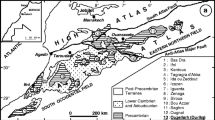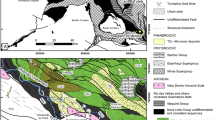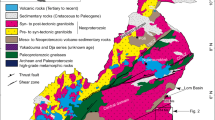Abstract
The Hutti gold mine is located in a high-angle, NNW–SSE-trending shear zone system, which hosts nine discrete auriferous shear zones (reefs). On a clockwise, retrograde PT path two separate stages of deformation/metamorphism (D2/M2 and D3/M3) occurred synchronous with two distinct stages of gold mineralization, both of which were associated with different fluid types. Stage 1 mineralization developed during D2/M2, where the amphibolite host rocks were altered by a metamorphic fluid with a \( {{\delta }^{{18}}}{{O}_{{{{H}_2}O}}} \)of 7.5–10.1 ‰, rich in K, S, As, and Au at pressure and temperature conditions of around 3 kbar and 530 + 20/−30°C, respectively. The stage 1 auriferous shear zones are enveloped by a zoned alteration consisting of a distal biotite–chlorite and proximal biotite–plagioclase assemblage. Subsequently, D2/M2 was overprinted by D3/M3 deformation and metamorphism at 300–400°C and <2 kbar that formed the stage 2 mineralization. The stage 2 mineralizing fluid which originated from outside the greenstone belt (δ18Ofluid of 3.2–6.8 ‰) was rich in Si, Au, and W. This mineralization stage is distinct by the emplacement of laminated quartz veins central to the shear zone, containing locally visible gold at concentrations of up to 1 kg Au/t. The laminated quartz veins are surrounded by a millimeter-scale chlorite2–K-feldspar alteration halo, which replaced the stage 1 biotite–plagioclase assemblage. The oxygen isotopic composition of the stage 2 fluid suggests a mixture of a magmatic fluid with an oxygen isotopic composition in the range of 6 to 10 ‰ and an isotopically light formation fluid that resulted from fluid–rock interaction in the greenstone pile. The two fluid fluxes at stages 1 and 2 both contributed to the overall gold mineralization; however, it was the second fluid pulse, which gave the Hutti mine its status as the largest gold mine in India. The metamorphic evolution was thereby important for the first stage, whereas the second stage was controlled by tectonism and intrusion of the high-heat production Yellagatti granite that re-established the fluid plumbing and mineralizing system.








Similar content being viewed by others
References
Anand R, Balakrishnan S, Mezger K (2005) Geochemical and geochronological studies on titanites from the granitoid rocks of the Eastern Dharwar Craton, South India. Geophys Res Abstracts 7: SRef-ID: 1607-7962/gra/EGU1605-A-01565
Beaudoin G, Pitre D (2005) Stable isotope geochemistry of the Archean Val-d‘Or (Canada) orogenic gold vein field. Miner Deposita 40:59–75
Bierlein FP, Arne DC, McKnight S, Lu J, Reeves S, Besanko J, Marek J, Cooke D (2000) Wall-rock petrology and geochemistry in alteration halos associated with mesothermal gold mineralization, Central Victoria, Australia. Econ Geol 95:283–312
Bierlein FP, Cartwright I, McKnight S (2001) The role of carbonaceous “indicator” slates in the genesis of lode gold mineralization in the Western Lachlan Orogen, Victoria, Southeastern Australia. Econ Geol 96:431–451
Bucci LA, Hagemann S, Groves DI, Standing JG (2002) The Archean Chalice gold deposit: a record of complex, mulistage, high-temperature hydrothermal activity and gold mineralisation associated with granitic rocks in the Yilgarn Craton, Western Australia. Ore Geol Rev 19:23–67
Clayton RN, O’Neil JR, Mayeda TK (1972) Oxygen isotope exchange between quartz and water. J Geophys Res 77:3057–3067
Connolly JAD (1990) Multivariable phase diagrams: an algorithm based on generalized thermodynamics. Am J Sci 290:666–718
Curtis LC, Radhakrishna BP (1995) Hutti goldmine—into the 21st century. Geological Society of India, Bangalore
Dziggel A, Otto A, Kisters AFM, Meyer FM (2007) Tectono-metamorphic controls on Archaean gold mineralization in the Barberton greenstone belt, South Africa: an example from the New Consort gold mine. In: van Kranendonk MJ, Smithies RH, Bennet V (eds) Earth’s oldest rocks. Developments in Precambrian geology. Elsevier, Amsterdam
Dziggel A, Wulff K, Kolb J, Meyer FM (2009) Processes of high-T fluid–rock interaction during gold mineralization in carbonate-bearing metasediments: the Navachab gold deposit, Namibia. Miner Deposita 44:665–684
Dziggel A, Poujol M, Otto A, Kisters AFM, Trieloff M, Schwarz W, Meyer FM (2010) New U–Pb and 40Ar/39Ar ages from the northern part of the Barberton greenstone belt, South Africa: implications for the formation of Mesoarchaean gold deposits. Precambrian Res 179:206–220
Eisenlohr BN, Groves DI, Partington GA (1989) Crustal-scale shear zones and their significance to Archaean gold mineralization in Western Australia. Miner Deposita 24:1–8
Goldfarb RJ, Newberry RJ, Pickthorn WJ, Gent CA (1991) Oxygen, hydrogen, and sulphur isotope studies in the Juneau gold belt, southeastern Alaska: constraints on the origin of hydrothermal fluids. Econ Geol 86:66–80
Goldfarb RJ, Groves DI, Gardoll S (2001) Orogenic gold and geologic time: a global synthesis. Ore Geol Rev 18:1–75
Goldfarb RJ, Baker T, Dubé B, Groves DI, Hart CJR, Gosselin P (2005) Distribution, character, and genesis of gold deposits in metamorphic terranes. Econ Geol 100th Anniversary Volume:407–450
Groves DI (1993) The crustal continuum model for late-Archaean lode-gold deposits of the Yilgarn Block, Western Australia. Miner Deposita 28:366–374
Groves DI, Barley ME, Barnicoat AC, Cassidy KF, Fare RJ, Hagemann SG, Ho SE, Hronsky JMA, Mikucki EJ, Mueller AG, McNaughton NJ, Perring CS, Ridley JR, Vearncombe JR (1992) Sub-greenschist to granulite-hosted Archaean lode-gold deposits of the Yilgarn Craton: a depositional continuum from deep-sourced hydrothermal fluids in crustal-scale plumbing systems Geology Department (Key Centre) and University Extension. The University of Western Australia Publication, Perth, pp 325–337
Henry DJ, Guidotti CV (2002) Titanium in biotite from metapelitic rocks: temperature effects, crystal-chemical controls, and petrologic applications. Am Mineral 87:375–382
Ho SE, Groves DI, McNaughton NJ, Mikucki EJ (1992) The source of ore fluids and solutes in Archean lode gold deposits of Western Australia. J Volcanol Geotherm Res 50:173–196
Hoefs J (2009) Stable isotope geochemistry. Springer, Berlin
Holland TJB, Powell R (1998) An internally consistent thermodynamic data set for phases of petrological interest. J Metamorph Geol 16:309–344
Inoue A, Meunier A, Patrier-Mas P, Rigault C, Beaufort D, Vieillard P (2009) Application of chemical geothermometry to low-temperature trioctahedral chlorites. Clays Clay Miner 57:371–382
Kerrich R, Cassidy KF (1994) Temporal relationship of lode gold mineralization to accretion, magmatism, metamorphism and deformation—Archean to present: a review. Ore Geol Rev 9:263–310
Kerrich R, Fyfe WS (1981) The gold–carbonate association: source of CO2 and CO2 fixation reactions in Archean lode gold deposits. Chem Geol 33:265–294
Kerrich R, Wyman DA (1990) The geodynamic setting of mesothermal gold deposits: an association with accretionary tectonic regimes. Geology 18:882–885
Kerrich R, Goldfarb RJ, Groves DI, Garwin S (2000) The geodynamics of world-class gold deposits: characteristics, space–time distribution, and origins. In: Hagemann S, Brown PE (eds) Gold in 2000. Reviews in economic geology. Society of Economic Geologists, Littleton, pp 501–551
Kolb J, Meyer FM (2008) Balanced mineral reactions for alteration zones developed in auriferous shear zones of the Hutti Mine, Dharwar craton, India. Z Dtsch Ges Geowiss (ZDGG) 159:331–348
Kolb J, Kisters AFM, Hoernes S, Meyer FM (2000) The origin of fluids and nature of fluid–rock interaction in auriferous mylonites of the Renco Mine, southern Zimbabwe. Miner Deposita 35:109–125
Kolb J, Hellmann A, Rogers A, Sindern S, Vennemann TW, Böttcher ME, Meyer FM (2004a) The role of a transcrustal shear zone in orogenic gold mineralization at the Ajjanahalli Mine, Dharwar Craton, South India. Econ Geol 99:743–759
Kolb J, Rogers A, Meyer FM (2004b) Comment on the paper by Pandalai et al. Dissolution channels in quartz and the role of pressure changes in gold and sulfide deposition in the Archean, greenstone-hosted, Hutti gold deposit, Karnataka, India (Miner Deposita 38:597–624). Miner Deposita 39:114–116
Kolb J, Rogers A, Meyer FM, Vennemann TW (2004c) Development of fluid conduits in the auriferous shear zones of the Hutti Gold Mine, India: evidence for spatially and temporally heterogeneous fluid flow. Tectonophysics 378:65–84
Kolb J, Rogers A, Meyer FM (2005a) Relative timing of deformation and two-stage gold mineralization at Hutti mine, Dharwar Craton, India. Miner Deposita 40:156–174
Kolb J, Rogers A, Meyer FM, Siemes H (2005b) Dominant coaxial deformation of veins during the interseismic stage of the fault-valve cycle: microfabrics of laminated quartz veins of the Hutti Gold Mine, India. J Struct Geol 27:2043–2057
Kolb J, Sindern S, Kisters AFM, Meyer FM, Hoernes S, Schneider J (2005c) Timing of orogenic gold mineralization at Kochkar in the evolution of the East Uralian granite-gneiss terrane. Miner Deposita 40:473–491
Krienitz M-S, Trumbull RB, Hellmann A, Kolb J, Meyer FM, Wiedenbeck M (2008) Hydrothermal gold mineralization at the Hira Buddini gold mine, India: constraints on fluid evolution and fluid sources from boron isotopic compositions of tourmaline. Miner Deposita 43:421–434
Manikyamba C, Kerrich R, Khanna TC, Satyanarayanan M, Krishna AK (2009) Enriched and depleted arc basalts, with Mg-andesites and adakites: a potential paired arc-back-arc of the 2.6 Ga Hutti greenstone terrane, India. Geochim Cosmochim Acta 73:1711–1736
McCuaig TC, Kerrich R (1998) P-T-t deformation fluid characteristics of lode-gold deposits: evidence from alteration systematics. Ore Geol Rev 12:381–453
Mishra B, Pal N (2008) Metamorphism, fluid flux, and fluid evolution relative to gold mineralization in the Hutti-Maski greenstone belt, Eastern Dharwar craton, India. Econ Geol 103:801–827
Monecke T, Köhler S, Kleeberg R, Herzig PM, Gemmell JB (2001) Quantitative phase-analysis by the Rietveld method using X-ray powder-diffraction data: application to the study of alteration halos associated with volcanic-rock-hosted massive sulfide deposits. Can Mineral 39:1617–1633
Otto A, Dziggel A, Kisters AFM, Meyer FM (2007) The New Consort gold mine, Barberton greenstone belt, South Africa: orogenic gold mineralization in a condensed metamorphic profile. Miner Deposita 42:715–735
Pal N, Mishra B (2002) Alteration geochemistry and fluid inclusion characteristics of the greenstone-hosted gold deposit of Hutti, Eastern Dharwar Craton, India. Miner Deposita 37:722–736
Pandalai HS, Jadhav GN, Mathew B, Panchapakesan V, Raju KK, Patil ML (2003) Dissolution channels in quartz and the role of pressure changes in gold and sulfide deposition in the Archean, greenstone-hosted, Hutti gold deposit, Karnataka, India. Miner Deposita 38:597–624
Phillips GN, Evans KA (2004) Role of CO2 in the formation of gold deposits. Nature 429:860–863
Phillips GN, Powell R (2010) Formation of gold deposits: a metamorphic devolatilization model. J Metamorph Geol 28:689–718
Pitcairn IK, Teagle DAH, Craw D, Olivo GR, Kerrich R, Brewer TS (2006) Source of metals and fluids in orogenic gold deposits: insights from the Otago and Alpine schists, New Zealand. Econ Geol 101:1525–1546
Rausell-Colom JA, Wiewióra A, Matesanz E (1991) Relationship between composition and d001 for chlorite. Am Mineral 76:1373–1379
Ridley JR, Diamond LW (2000) Fluid chemistry of orogenic lode gold deposits and implications for genetic models. In: Hagemann S, Brown PE (eds) Gold in 2000. Reviews in economic geology. Society of Economic Geologists, Littleton, pp 141–162
Rogers A (2004) Petrological, geochemical and stable isotope characterisation of auriferous shear zones at the Hutti Gold Mine, Dharwar Craton, India. Fachgruppe Geowissenschaften der RWTH Aachen, Aachen
Rogers AJ, Kolb J, Meyer FM, Armstrong RA (2007) Tectono-magmatic evolution of the Hutti-Maski Greenstone Belt, India: constrained using geochemical and geochronological data. J Asian Earth Sci 31:55–70
Roy A (1979) Polyphase folding deformation in the Hutti-Maski schist belt, Karnataka. J Geol Soc India 20:598–607
Rumble D III, Hoering TC (1994) Analysis of oxygen and sulfur isotope ratios in oxide and sulfide minerals by spot heating with a carbon dioxide laser in a fluorine atmosphere. Acc Chem Res 27:237–241
Sarma DS, McNaughton NJ, Fletcher IA, Groves DI, Mohan MR, Balaram V (2008) Timing of gold mineralization in the Hutti gold deposit, Dharwar craton, south India. Econ Geol 103:1715–1727
Sharp ZD, Atudorei V, Durakiewicz (2001) A rapid method for determination of hydrogen and oxygen isotope ratios from water and hydrous minerals. Chem Geol 178:197–210
Srikantia SV (1995) Geology of the Hutti-Maski greenstone belt. In: Curtis LC, Radhakrishna BP (eds) Hutti gold mine into the 21st century. Geological Society of India, Bangalore, pp 8–27
Stüwe K, Will TH, Zhou S (1993) On the timing relationship between fluid production and metamorphism in metamorphic piles: some implications for the origin of post-metamorphic gold mineralisation. Earth Planet Sci Lett 114:417–430
Vasudev VN, Chadwick B, Nutman AP, Hedge GV (2000) Rapid development of the Late Archaean Hutti schist belt, northern Karnataka: implications of new field data and SHRIMP U/Pb zircon ages. J Geol Soc India 55:529–540
Wiewióra A, Weiss Z (1990) Crystallochemical classifications of phyllosilicates based on the unified system of projection of chemical composition: II. The chlorite group. Clay Miner 25:83–92
Author information
Authors and Affiliations
Corresponding author
Additional information
Editorial handling: B. Lehmann
Rights and permissions
About this article
Cite this article
Rogers, A.J., Kolb, J., Meyer, F.M. et al. Two stages of gold mineralization at Hutti mine, India. Miner Deposita 48, 99–114 (2013). https://doi.org/10.1007/s00126-012-0416-5
Received:
Accepted:
Published:
Issue Date:
DOI: https://doi.org/10.1007/s00126-012-0416-5




